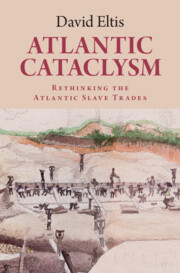Book contents
- Atlantic Cataclysm
- Atlantic Cataclysm
- Copyright page
- Epigraph
- Dedication
- Contents
- Figures
- Tables
- Maps
- Preface
- Acknowledgements
- Abbreviations
- 1 Atlantic Slave Trading and World History
- 2 The Americas and Atlantic Slave Trading: The Iberians and the Rest
- 3 Europe and Atlantic Slave Trading
- 4 The Portuguese System
- 5 Africa, Africans, and the Slave Trade
- 6 Abolition: A Leninist Interpretation
- 7 Freedom?
- Conclusion
- Index
6 - Abolition: A Leninist Interpretation
Published online by Cambridge University Press: 13 December 2024
- Atlantic Cataclysm
- Atlantic Cataclysm
- Copyright page
- Epigraph
- Dedication
- Contents
- Figures
- Tables
- Maps
- Preface
- Acknowledgements
- Abbreviations
- 1 Atlantic Slave Trading and World History
- 2 The Americas and Atlantic Slave Trading: The Iberians and the Rest
- 3 Europe and Atlantic Slave Trading
- 4 The Portuguese System
- 5 Africa, Africans, and the Slave Trade
- 6 Abolition: A Leninist Interpretation
- 7 Freedom?
- Conclusion
- Index
Summary
The chapter reviews the scholarly interpretations of abolition that have appeared in the last two decades. One group, influenced by Eric Williams, looks for economic motivations stemming from a decline of the British plantation sector; a second focuses on rebellions by slaves, the chief of which was that in St. Domingue, which gave birth to Haiti in 1802. Some in this category see the slaves freeing themselves. Others argue for long-run changes in public attitudes toward violence within Western Europe, especially England, that occurred in the 150 years after the British established their Caribbean plantations. In the eighteenth century the nascent London press began to report slaves resistance to enslavement both on board slave ships and in Caribbean colonies. These reports became more frequent and more detailed as the century progressed. Other cruelties such as burning at the stake, abandoning children, masters’ right to chastise their servants, and the lords’ power over their serfs (in mainland Europe) either ceased or became less frequently exercised. At the same time awareness of Africans and their forced use in the Americas as represented in the London press greatly increased after 1750. Where “slaves” meant English captives in North Africa at the beginning of the century, by 1800 the term referred to Blacks in the Americas.
- Type
- Chapter
- Information
- Atlantic CataclysmRethinking the Atlantic Slave Trades, pp. 247 - 291Publisher: Cambridge University PressPrint publication year: 2025

